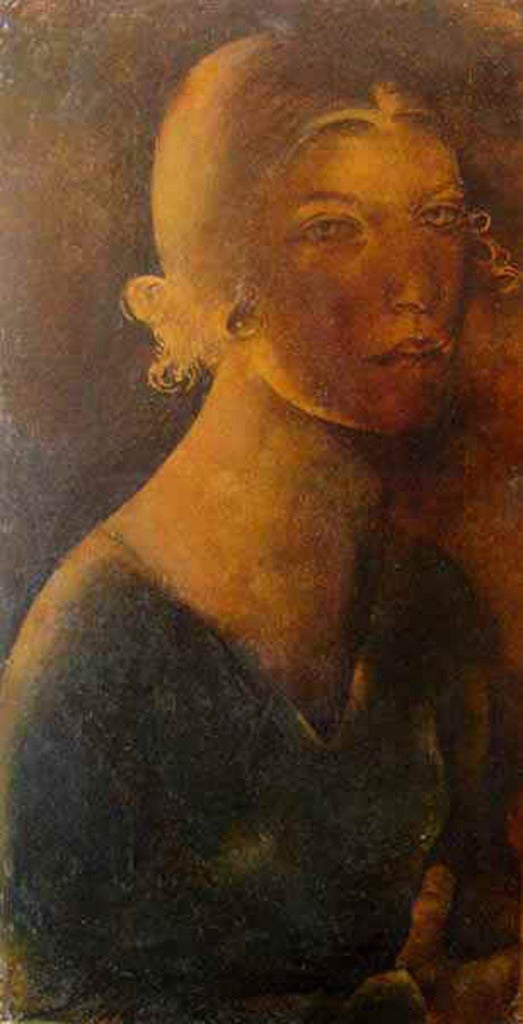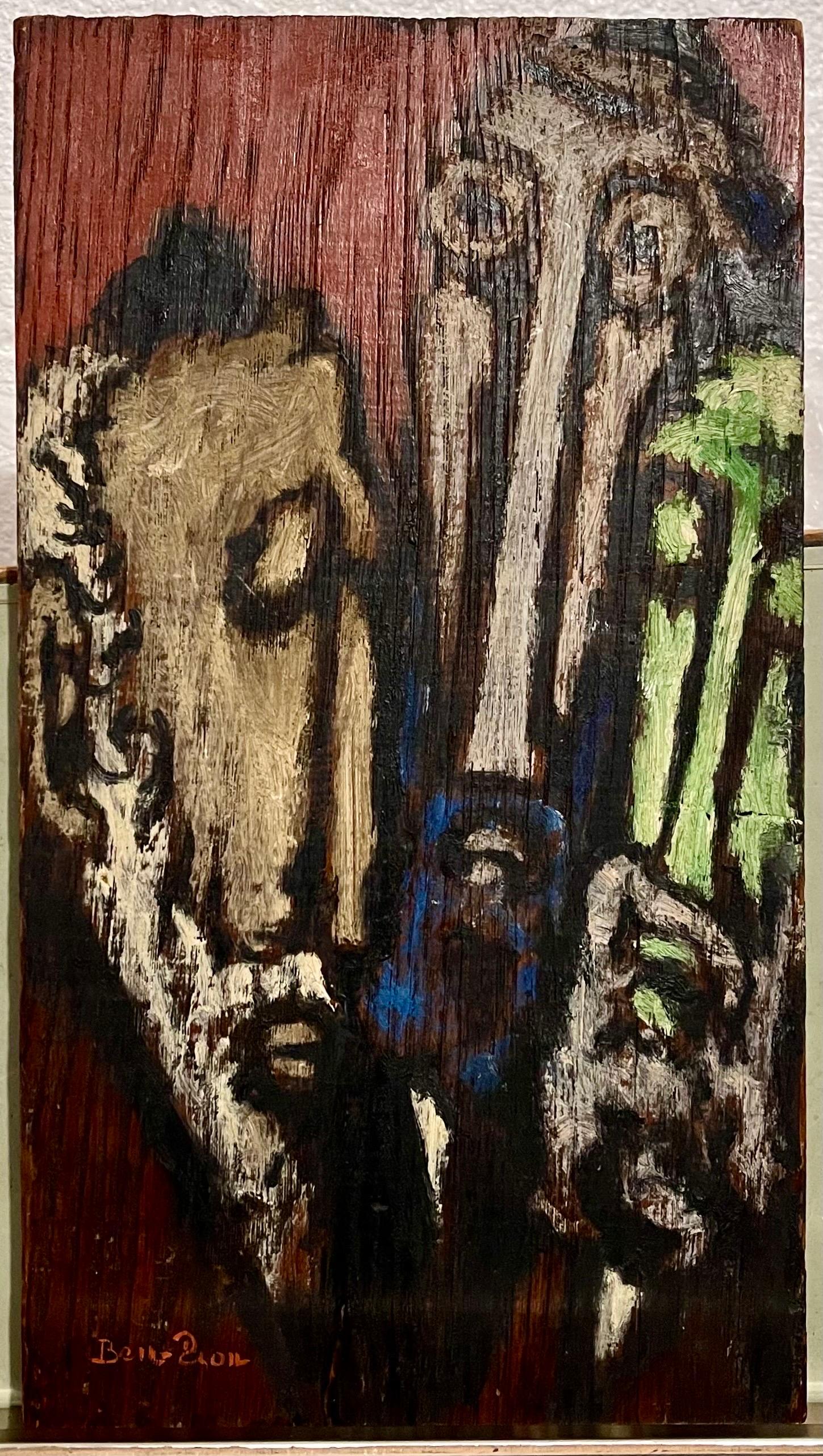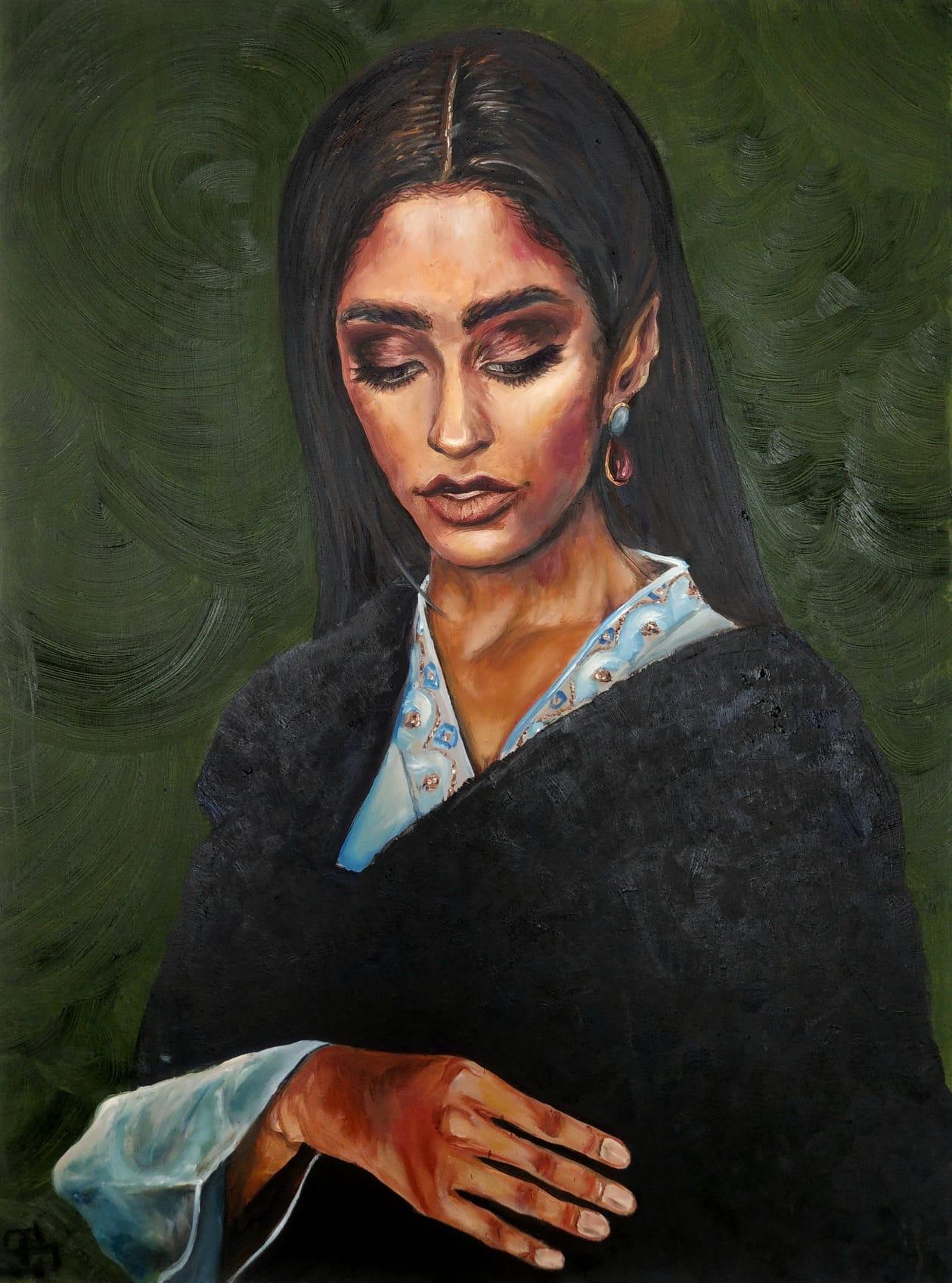Items Similar to Portrait with Pearl Necklace
Want more images or videos?
Request additional images or videos from the seller
1 of 5
Erich WaskePortrait with Pearl Necklace
About the Item
Deling with the work of Erich Waske today, one encounters first of all a number of reasons why this outstanding artist has fallen into such undeserved oblivion. In addition to the destruction of his studio and thus much of the previous life’s work in the Second World War and his unadapted personality, this includes the careless handling of his own estate. While Waske is almost unknown in the public perception of the art world, he was considered during his lifetime as one of the most important representatives of German Expressionism, which was part of the extended “Brücke” artist collective. Two monographs were published as early as 1921, he exhibited with Schmidt-Rottluff, Kandinsky and Pechstein and also had their – already then very high – price level. This fact makes Erich Waske a veritable discovery of classical modernism in Germany.
The predominant expressive quality of the work of Erich Waske lies in his sovereign handling of the color, which earned him the nickname “Symphonist of Colours”. The works of the – largely lost – early work are characterized by a gestural ductus; Over time, the color palette is reduced but more powerful, flat and richer in contrast. With a palette of mostly two or three colors – often violet, orange and blue – a maximum effect is attained that actually gives one an impression of a musical quality in the sense of harmony, rhythm and tension. His landscape paintings are never about topographical depiction, but about energetic exaggeration and visionary symbolism. It is impressive how with such easy methods Erich Waske captures color-charged energy on canvas.
In sum, paint and composition in Waske’s works create a monumentality that is completely independent of the actual format of the work. Both landscapes and portraits radiate with majestic greatness, from the contemplative intimacy of many of his idealizing portraits of women to the eruptive power of his depictions of volcanos. Waske has actually created a whole series of monumental frescoes and was never defeated by the format of his works. The power of the objects, the power of the depicted persons is also visible in his small-format works through reduction to the essentials and increase in color contrasts. All those features give Waske’s works general validity and high symbolic power.
Erich Waske remained true to his style until very old age, but no longer witnessed the later new appreciation for the German Expressionists. It is about time that the artist’s most important works are honored in a large solo exhibition that focuses on a monumental color symphonist and visionary of timeless validity.
- Creator:Erich Waske (1889 - 1979, German)
- Dimensions:Height: 30.91 in (78.5 cm)Width: 15.75 in (40 cm)
- Medium:
- Movement & Style:
- Period:
- Condition:
- Gallery Location:Wien, AT
- Reference Number:1stDibs: LU1782212594042
About the Seller
No Reviews Yet
Vetted Seller
These experienced sellers undergo a comprehensive evaluation by our team of in-house experts.
Established in 1973
1stDibs seller since 2022
5 sales on 1stDibs
- ShippingRetrieving quote...Ships From: Wien, Austria
- Return PolicyA return for this item may be initiated within 7 days of delivery.
More From This SellerView All
- Portrait of a WomanBy Erich WaskeLocated in Wien, 9Deling with the work of Erich Waske today, one encounters first of all a number of reasons why this outstanding artist has fallen into such undeserved oblivion. In addition to the de...Category
20th Century Expressionist Portrait Paintings
MaterialsOil, Panel
- Sitzende Dame / Seated LadyBy Leo PutzLocated in Wien, 9This work by Leo Putz was created during his Expressionist period. The broad stroke, the reductions and the distance from the realistic mode of representation are significant. The li...Category
20th Century Modern Figurative Paintings
MaterialsOil, Panel
- Mein VaterBy Heinz Otto LaubLocated in Wien, 9Heinz-Otto Laub was born 1944 in Cologne (Germany), studied at the KA Munich under Mac Zimmermann and is actually working in Bonn. He is known in the first place for his surrealistic...Category
1970s Contemporary Portrait Paintings
MaterialsOil, Panel
- Ich in meinen BildernBy Karl Anton FleckLocated in Wien, 9Der begnadete Zeichner Karl Anton Fleck wurde vor kurzem mit einer Personalen in der Albertina geadelt. In dieser Ausstellung fehlte allerdings etwas ganz Entscheidendes: Eines der w...Category
1960s Modern Portrait Paintings
MaterialsWood Panel, Oil
- Sitzende FrauBy Fritz SchmidtLocated in Wien, 9signed on the lower left The painting can be categorised in the tradition of New Objectivity. The picture shows a real scene, the woman depicted stares into space with a serious and...Category
20th Century Modern Figurative Paintings
MaterialsCanvas, Oil
- Lesendes MädchenBy Vilma EcklLocated in Wien, 9The extensive work of Vilma Eckl covers a period of more than seventy years. Her incomparable artistic talent and her essential contribution to the history of art can be seen in her ...Category
1920s Modern Figurative Paintings
MaterialsCanvas, Oil
You May Also Like
- MargitBy Otto Tetjus TugelLocated in West Hollywood, CAPresenting a rare oil on panel by German artist Otto Tugel. Otto Tugel worked in Germany before settling in New York. This is an early oil on panel, signed in monogram, dated 1925.Category
1920s Expressionist Figurative Paintings
MaterialsOil, Panel
- Expressionist Judaica Rabbis Oil Painting Jewish American WPA Modernist Ben ZionBy Ben-Zion WeinmanLocated in Surfside, FLRabbinical Discussion Hand signed lower left. Provenance: bears label verso for Summit Gallery Dimensions: H 14.25" x W 8" Born in 1897, Ben-Zion Weinman celebrated his European Jewish heritage in his visual works as a sculptor, painter, and printmaker. Influenced by Spinoza, Knut Hamsun, and Wladyslaw Reymont, as well as Hebrew literature, Ben-Zion wrote poetry and essays that, like his visual work, attempt to reveal the deep “connection between man and the divine, and between man and earth.” An emigrant from the Ukraine, he came to the US in 1920. He wrote fairy tales and poems in Hebrew under the name Benzion Weinman, but when he began painting he dropped his last name and hyphenated his first, saying an artist needed only one name. Ben-Zion was a founding member of “The Ten: An Independent Group” The Ten” a 1930’s avant-garde group, Painted on anything handy. Ben-Zion often used cabinet doors (panels) in his work. Other members of group included Ilya Bolotowsky, Lee Gatch, Adolph Gottlieb, Louis Harris, Yankel Kufeld, Marcus Rothkowitz (later known as Mark Rothko), Louis Schanker, and Joseph Solman. The Art of “The Ten” was generally described as expressionist, as this style offered the best link between modernism and social art. Their exhibition at the Mercury Gallery in New York held at the same time as the Whitney Annual Exhibition of Contemporary American Painting, included a manifesto concentrating on aesthetic questions and criticisms of the conservative definition of modern art imposed by the Whitney. Ben-Zion’s work was quickly noticed. The New York Sun said he painted “furiously” and called him “the farthest along of the lot.” And the triptych, “The Glory of War,” was described by Art News as “resounding.” By 1939, The Ten disbanded because most of the members found individual galleries to represent their work. Ben-Zion had his first one-man show at the Artist’s Gallery in Greenwich Village and J.B. Neumann, the highly esteemed European art dealer who introduced Paul Klee, (among others) to America, purchased several of Ben-Zion’s drawings. Curt Valentin, another well-known dealer, exhibited groups of his drawings and undertook the printing of four portfolios of etchings, each composed of Ben-Zion’s biblical themes. He worked as a WPA artist. Ben-Zion’s work is represented in many museums throughout the country including the Metropolitan, the Whitney, and the Museum of Modern Art in New York, the Art Institute of Chicago, the Philadelphia Museum of Art and the Phillips Collection, Washington. The Jewish Museum in New York opened in 1948 with a Ben-Zion exhibition. Ben-Zion consistently threaded certain subject matter—nature, still life, the human figure, the Rabbi, the Hebrew Bible, and the Jewish people—into his work throughout his life. "In all his work a profound human feeling remains. Sea and sky, even sheaves of wheat acquire a monolithic beauty and simplicity which delineates the transient as a reflection of the eternal. This sensitive inter- mingling of the physical and metaphysical is one of the most enduring features of Ben-Zion's works." (Excerpt from Stephen Kayser, “Biblical Paintings,” The Jewish Museum Catalogue, 1952). Mystical Imprints: Marc Chagall, Ben-Zion, and Ben Shahn presents the print work of three prominent 20th century Jewish artists born in the Russian Empire. Among these seventy pieces are etchings and lithographs from Chagall’s Bible series...Category
Mid-20th Century Expressionist Figurative Paintings
MaterialsOil, Wood Panel
- Lynx speak Nicolas Kennett 21st Century Bristish painting portrait expressionistLocated in Paris, FROil paint on wood panel Signed on the back "Incanto" or the enchantment of shifting "Nicolas Kennett revisits the organic world through painted and sc...Category
2010s Expressionist Figurative Paintings
MaterialsOil, Wood Panel
- Latin Lady, Original Signed Contemporary Expressionist Figurative PaintingBy Sharon SiebenLocated in Boston, MALatin Lady, Original Contemporary Expressionist Figurative Painting, 2021 30" x 15" x 1.5" (HxWxD) Mixed Media and Acrylic on Paper bonded to a Wood Panel Hand-signed by the artist. ...Category
21st Century and Contemporary Expressionist Figurative Paintings
MaterialsPaper, Acrylic, Mixed Media, Wood Panel
- The New WifeLocated in Brooklyn, NYThe painting is an oil on canvas, measuring 48" x 36". The painting is multilayered to show skin texture, and source of light. The painting shows a young woman fixing her shawl, an a...Category
2010s Expressionist Figurative Paintings
MaterialsCanvas, Oil
- Bargain AuntyLocated in Brooklyn, NYThe painting is an oil on canvas, measuring 45" x 33". There is a lot of texture on this painting created by cigarette butts and ash mixed with oil paint, smeared on the canvas to highlight the hair. The painting shows a character inspired by Bollywood, in the market, reflecting on all the patterns and designs she sees in a South Asian jewelry...Category
2010s Expressionist Portrait Paintings
MaterialsOil, Canvas
Recently Viewed
View AllMore Ways To Browse
Arcadia Antiques
Bola Obatuyi
Hunt Slonem Majesty
Hunt Slonem Queen Elizabeth
Louis Cheron
Queen Elizabeth Slonem
Slonem Majesty
Angus Martin
Edward De Vere
Faiza Maghni
Gerald Nees
Hunt Slonem Abe Lincoln
John Hollins
Maude Clay
Old Pretender
Original Oil Portrait Of Queen Elizabeth 2
Glyn Warren Philpot
Gregorio Fur





